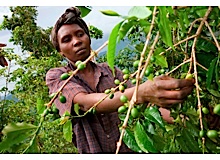
A large literature exists on commercialisation — broadly defined as having greater engagement with markets, either for inputs, outputs, or both — of small, family farms.
Studies and reviews address the following questions:
- Under what conditions, and with what encouragement from policy, may small farms be commercialised? Is it sufficient to provide roads and physically connect farmers to market?
- Does commercialisation benefit smallholding households? Does this improve or worsen food security? How does this affect the position of females within the household?
- Does commercialisation lead to loss of land for small farmers? Does it lead to increased social differentiation of the peasantry? Does it lead to loss of independence, and increasing dependency on private corporations able to exercise monopoly power to take the lion’s share of the benefits?
- Does commercialisation raise risks in the markets to unacceptable levels? Do different abilities to bear risk mean that some farmers can take the opportunities while others dare not?
- What is the impact of commercialisation on those with little or no land? Are they marginalised, or do they benefit through labour markets and other linkages in the rural economy?
- Does commercialisation lead to over-use of natural resources or otherwise degrade the environment?
In the broadest terms, there are two answers to the above questions. The first and most obvious answer is that it all depends. So many factors mediate the impacts of the varying forms and degrees of commercialisation, that it is possible to observe all manner of outcomes.
The second reply would be that most of the overviews [e.g. von Braun et al., Leavy & Poulton, Jaleta et al.] are cautiously optimistic about the feasibility and desirability of commercialisation. There are enough cases of positive changes to argue that encouraging commercialisation can be effective in most developing countries.
The initial findings from the village studies carried out so far under FAC, plus those by SUA Morogoro, confirm the latter conclusion: small farms can successfully commercialise. There are even suggestions from the labour statistics that however uneven the process may be, there may be wider benefits in the local economy.
Future Work
Two broad sets of questions may be addressed by future FAC work:
- What are the dynamics seen in farming systems and local rural economies in communities where small farmers are commercialising? And, more specifically,
- How strong are the resulting multipliers in the local rural economy? How do they compare to what might be expected from comparable larger-scale agricultural development?
{jcomments off}
